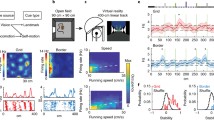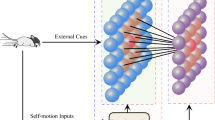Abstract
Spatial navigation relies on various types of neurons to form an internal representation in the brain of the external world. Among them, grid cells are generally believed to serve as an invariant metric system by their spatially periodic firing fields. But how this metrical coordinate system is organized in three-dimensional (3-D) real world remains a mystery, since most researches merely concerned the encoding scheme on the horizontal plane. We computationally explored the activity pattern of grid cell in the medial entorhinal cortex of crawling animal in 3-D space. By including the presumably referring signals of gravity and animal’s body plane, grid cell firing fields on curved surfaces were produced based on the novel gravity-modulated oscillatory model. The results can account for the known experimental recordings and predict a mosaic-type grid code consisting of dynamically rotated planar arrangements. We further analyzed the path integration mechanism and derived the condition to ensure the invariant grid fields on any curved surface in 3-D space. It turns out that if the grid code is indeed not fully volumetric, it may become trajectory-dependent in 3-D space. And thus for crawling animals, 3-D grid fields could be degenerated and impaired, causing the path integration and distance measurement inaccurate. Besides, the volumetric firing fields were also discussed, although it is more suitable for flying or aquatic animals. This work can help us understand the intrinsically different spatial codes and navigating abilities among species with various locomotion modes and provide new insights of how the actual physical world is represented in the brain.




Similar content being viewed by others
References
Tolman, E.C.: Cognitive maps in rats and men. Psychol. Rev. 55(4), 189–208 (1948)
O’Keefe, J., Dostrovsky, J.: The hippocampus as a spatial map. Preliminary evidence from unit activity in the freely-moving rat. Brain Res. 34(1), 171–5 (1971)
O’Keefe, J., Recce, M.L.: Phase relationship between hippocampal place units and the EEG theta rhythm. Hippocampus 3(3), 317–330 (1993)
Yates, D.: Place cells as route planners. Nat. Rev. Neurosci. 14(6), 380–381 (2013)
Wang, Y., Wang, R., Zhu, Y.: Optimal path-finding through mental exploration based on neural energy field gradients. Cognit. Neurodyn. 11(1), 99–111 (2017)
Zeng, T., Si, B.: A brain-inspired compact cognitive mapping system. Cognit. Neurodyn. (2020). https://doi.org/10.1007/s11571-020-09621-6
Sargolini, F., Fyhn, M., Hafting, T., McNaughton, B.L., Witter, M.P., Moser, M.B., et al.: Conjunctive representation of position, direction, and velocity in entorhinal cortex. Science 312(5774), 758–62 (2006)
Hafting, T., Fyhn, M., Molden, S., Moser, M.B., Moser, E.I.: Microstructure of a spatial map in the entorhinal cortex. Nature 436(7052), 801–806 (2005)
Fyhn, M., Molden, S., Moser, E.I., Moser, M.B.: Spatial representation in the entorhinal cortex. Science 305(5688), 1258–1264 (2004)
Barry, C., Hayman, R., Burgess, N., Jeffery, K.: Experience-dependent rescaling of entorhinal grids. Nat. Neurosci. 10(6), 682–684 (2007)
McNaughton, B.L., Battaglia, F.P., Jensen, O., Moser, E.I., Moser, M.B.: Path integration and the neural basis of the ‘cognitive map’. Nat. Rev. Neurosci. 7(8), 663–78 (2006)
Finkelstein, A., Las, L., Ulanovsky, N.: 3-D maps and compasses in the brain. Ann. Rev. Neurosci. 39, 171–96 (2016)
Yoon, K., Lewallen, S., Kinkhabwala, A.A., Tank, D.W., Fiete, I.R.: Grid cell responses in 1D environments assessed as slices through a 2D lattice. Neuron 89(5), 1086–1099 (2016)
Domnisoru, C., Kinkhabwala, A.A., Tank, D.W.: Membrane potential dynamics of grid cells. Nature 495(7440), 199–204 (2013)
Hayman, R., Casali, G., Wilson, J.J., Jeffery, K.: Grid cells on steeply sloping terrain: evidence for planar rather than volumetric encoding. Front. Psychol. 6, 925 (2015)
Hayman, R., Verriotis, M.A., Jovalekic, A., Fenton, A.A., Jeffery, K.J.: Anisotropic encoding of three-dimensional space by place cells and grid cells. Nat. Neurosci. 14(9), 1182–8 (2011)
Wang, Y., Xu, X., Wang, R.: An energy model of place cell network in three dimensional space. Front. Neurosci. 12, 264 (2018)
Wang, Y., Xu, X., Wang, R.: The place cell activity is information-efficient constrained by energy. Neural Netw. 116, 110–118 (2019)
Wang, Y., Wang, R., Xu, X.: Neural energy supply-consumption properties based on Hodgkin–Huxley model. Neural Plast. 2017, 6207141 (2017)
Wang, Y., Xu, X., Wang, R.: Energy features in spontaneous up and down oscillations. Cognit. Neurodyn. (2020). https://doi.org/10.1007/s11571-020-09597-3
Tsoar, A., Nathan, R., Bartan, Y., Vyssotski, A., Dell’Omo, G., Ulanovsky, N.: Large-scale navigational map in a mammal. Proc. Natl. Acad. Sci. USA 108(37), E718–E724 (2011)
Ulanovsky, N., Moss, C.F.: What the bat’s voice tells the bat’s brain. Proc. Natl. Acad. Sci. USA 105(25), 8491–8498 (2008)
Yartsev, M.M., Ulanovsky, N.: Representation of three-dimensional space in the hippocampus of flying bats. Science 340(6130), 367–372 (2013)
Yartsev, M.M., Witter, M.P., Ulanovsky, N.: Grid cells without theta oscillations in the entorhinal cortex of bats. Nature 479(7371), 103–7 (2011)
Casali, G., Bush, D., Jeffery, K.: Altered neural odometry in the vertical dimension. Proc. Natl. Acad. Sci. USA 116(10), 4631–4636 (2019)
Chen, X., Yang, T.: A neural network model of basal ganglia’s decision-making circuitry. Cognit. Neurodyn. (2020). https://doi.org/10.1007/s11571-020-09609-2
Tozzi, A., Ahmad, M.Z., Peters, J.F.: Neural computing in four spatial dimensions. Cognit. Neurodyn. (2020). https://doi.org/10.1007/s11571-020-09598-2
Wang, Y., Xu, X., Zhu, Y., Wang, R.: Neural energy mechanism and neurodynamics of memory transformation. Nonlinear Dyn. 97(1), 697–714 (2019)
Riley, S.N., Davies, J.: A spiking neural network model of spatial and visual mental imagery. Cognit. Neurodyn. 14(2), 239–251 (2020)
Tozzi, A., Peters, J.F.: Points and lines inside human brains. Cognit. Neurodyn. 13(5), 417–428 (2019)
Giocomo, L.M., Moser, M.B., Moser, E.I.: Computational models of grid cells. Neuron 71(4), 589–603 (2011)
Burgess, N., Barry, C., O’Keefe, J.: An oscillatory interference model of grid cell firing. Hippocampus 17(9), 801–12 (2007)
Geisler, C., Robbe, D., Zugaro, M., Sirota, A., Buzsaki, G.: Hippocampal place cell assemblies are speed-controlled oscillators. Proc. Natl. Acad. Sci. USA 104(19), 8149–8154 (2007)
Zilli, E.A., Hasselmo, M.E.: Coupled noisy spiking neurons as velocity-controlled oscillators in a model of grid cell spatial firing. J. Neurosci. 30(41), 13850–60 (2010)
Trettel, S.G., Trimper, J.B., Hwaun, E., Fiete, I.R., Colgin, L.L.: Grid cell co-activity patterns during sleep reflect spatial overlap of grid fields during active behaviors. Nat. Neurosci. 22(4), 609–617 (2019)
Burak, Y., Fiete, I.R.: Accurate path integration in continuous attractor network models of grid cells. PLoS Comput. Biol. 5(2), e1000291 (2009)
Fuhs, M.C., Touretzky, D.S.: A spin glass model of path integration in rat medial entorhinal cortex. J. Neurosci. 26(16), 4266–76 (2006)
Burgess, N.: Grid cells and theta as oscillatory interference: theory and predictions. Hippocampus 18(12), 1157–74 (2008)
Burgess, N., O’Keefe, J.: Models of place and grid cell firing and theta rhythmicity. Curr. Opinion Neurobiol. 21(5), 734–44 (2011)
Laurens, J., Kim, B., Dickman, J.D., Angelaki, D.E.: Gravity orientation tuning in macaque anterior thalamus. Nat. Neurosci. 19(12), 1566–1568 (2016)
Porter, B.S., Schmidt, R., Bilkey, D.K.: Hippocampal place cell encoding of sloping terrain. Hippocampus 28(11), 767–782 (2018)
Horiuchi, Timothy K., Moss, Cynthia F.: Grid cells in 3-D: reconciling data and models. Hippocampus 25, 1489–1500 (2015)
Zilli, Eric A.: Models of grid cell spatial firing published 2005–2011. Front. Neural Circuits 6, 16 (2012)
Acknowledgements
We thank the editor and anonymous reviewers for their valuable feedback and insightful advice. This work is supported by the National Natural Science Foundation of China (No.11802095, 11702096, 11972159, 11872180), the Natural Science Foundation of Shanghai (No. 19zr1473100), the Fundamental Research Funds for the Central Universities (No. 22201814025) and the research fund of East China University of Science and Technology (No. 50621111901004).
Author information
Authors and Affiliations
Corresponding author
Ethics declarations
Conflicts of interest
The authors declare that they have no conflict of interest.
Additional information
Publisher's Note
Springer Nature remains neutral with regard to jurisdictional claims in published maps and institutional affiliations.
Rights and permissions
About this article
Cite this article
Wang, Y., Xu, X., Pan, X. et al. Grid cell activity and path integration on 2-D manifolds in 3-D space. Nonlinear Dyn 104, 1767–1780 (2021). https://doi.org/10.1007/s11071-021-06337-y
Received:
Accepted:
Published:
Issue Date:
DOI: https://doi.org/10.1007/s11071-021-06337-y




